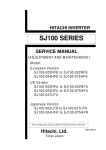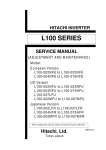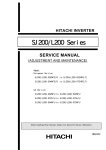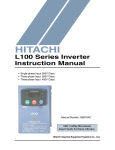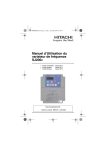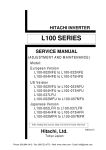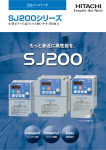Download Hitachi NB5741XD User's Manual
Transcript
HITACHI L100-M Series Inverter Quick Reference Guide • Single-phase Input 100V Class Hitachi Industrial Equipment Systems Co., Ltd. Manual No. NB5741XD • December 2003 Caution: Be sure to read the L100 Inverter Manual and follow its Cautions and Warnings for the initial product installation. This Quick Reference Guide is intended for reference use by experienced users in servicing existing installations. Power Circuit Terminals –002NFE/NFU, –004NFE/NFU, –005NFE Jumper (/) L1 +1 + – L2 N/L3 U/T1 V/T2 W/T3 Chassis Ground –007 to 022NFE/NFU, –037LFU, 004 to 040HFE/HFU Jumper (/) +1 L1 + – L2 N/L3 U/T1 V/T2 W/T3 Chassis Ground –055LFU, –075LFU, 055HFE/HFU, 075HFE/HFU Jumper (/) +1 + – L1 L2 N/L3 U/T1 V/T2 W/T3 Chassis Ground 1 Control Circuit Terminals Logic inputs L 5 4 3 2 1 P24 H O OI L FM CM2 12 11 Analog inputs Analog outputs Logic outputs AL0 AL1 AL2 Alarm relay Terminal Name Description Ratings and Notes P24 +24V for logic inputs 24VDC supply, 30 mA max. (Notes: Do not use for network power Do not short to terminal L) 1, 2, 3, 4, Intelligent (program5 mable) discrete logic inputs 27VDC max. (use P24 or an external supply referenced to terminal L), 4.7kΩ input impedance 11, 12 Discrete logic outputs 50 mA max. ON current, 27 VDC max. OFF voltage L (top row) GND for logic inputs Sum of input 1 to 5 currents (Note: Do not ground) CM2 Common for logic outputs 100 mA max for sum of terminals 11 and 12 currents PWM output 0 to 10VDC, 1 mA max., 50% duty cycle FM L (bottom Common for analog row) inputs OI Analog input, current 2 Sum of OI, O, and H currents (return) 4 to 19.6 mA range, 20 mA nominal Terminal Name Description Ratings and Notes O Analog input, voltage 0 to 9.6 VDC range, 10VDC nominal, 12VDC max., input impedance 10 kΩ H +10V analog reference 10VDC nominal, 10 mA max. AL0 Relay common contact Contact rating AL1 Relay contact, normally closed during RUN AL2 Relay contact, normally open during RUN 3 Max resistive load = 250VAC, 2.5A; 30VDC 3A; Max inductive load = 250VAC, 0.2A; 30VDC 0.7A Minimum load = 5VDC 100mA, 100VAC, 10mA Basic Wiring Diagram The following wiring diagram shows the power and motor connections for basic operation. The optional signal input wiring supports external Fwd and Rev Run command, and a speed potentiometer. L100 From 3-phase power input source (See specifications label on inverter for details) U R (T1) (L1) S V (L2) (T2) T W (N/L3) (T3) P24 AL1 1 AL0 2 AL2 Motor Inputs: Forward Alarm contacts, 1 Form C Reverse Open collector outputs: Run signal 12 Load Analog reference H External speed reference pot. Load O 11 Frequency arrival signal Logic output common L CM2 Analog common 4 Inverter Keypad Operation Run Key Enable LED Run/Stop LED Parameter Display Program/Monitor LED Power LED POWER HITACHI 5 0.0 RUN PRG RUN Hz A STOP RESET MAX MIN FUNC. 1 2 Display Units LEDs Hertz Amperes Potentiometer Enable LED Potentiometer STR Stop/Reset Key Run Key Up/Down Keys Store Key Function Key • Run/Stop LED – ON when the inverter output is ON and the motor is developing torque, and OFF when the inverter output is OFF (Stop Mode). • Program/Monitor LED – ON when the inverter is ready for parameter editing (Program Mode). It is OFF when the parameter display is monitoring data (Monitor Mode). • Run Key Enable LED – ON when the inverter is ready to respond to the Run key, OFF when the Run key is disabled. • Run Key – Press this key to run the motor (the Run Enable LED must be ON first). Parameter F_04, Keypad Run Key Routing, determines whether the Run key generates a Run FWD or Run REV command. • Stop/Reset Key – Press this key to stop the motor when it is running (uses the programmed deceleration rate). This key will also reset an alarm which has tripped. (continued, next page...) 5 • Potentiometer – Allows an operator to directly set the motor speed when the potentiometer is enabled for output frequency control. • Potentiometer Enable LED – ON when the potentiometer is enabled for value entry. • Parameter Display – A 4-digit, 7-segment display for parameters and function codes. • Display Units: Hertz/Amperes – One of these LEDs will be ON to indicate the units associated with the parameter display. • Power LED – ON when the power input to the inverter is ON. • Function Key – This key is used to navigate through the lists of parameters and functions for setting and monitoring parameter values. • Up/Down Keys – Use these keys alternately to move up or down the lists of parameter and functions shown in the display, and to increment/decrement values. • Store Key – When the unit is in Program Mode and the operator has edited a parameter value, press the Store key to write the new value to the EEPROM. 6 Keypad Navigation Map Monitor Mode Program Mode Display data o.0 Select Parameter Edit Parameter powerdown Store as powerup default FUNC. d 09 1 c 91 2 1 d 01 1 c 01 2 1 C –– 1 2 b –– 1 FUNC. 1 1 2 1 2 A 98 2 1 FUNC. 2 2 Edit FUNC. 1 2 3.4 b 01 2 F 04 1 2 b 89 A –– 1 Increment/ decrement value 2 FUNC. STR Write data to EEPROM A 01 2 F 01 Return to parameter list 7 Powerup Test The Powerup Test procedure uses minimal parameter settings to run the motor. The procedure describes two alternative methods for commanding the inverter: via the inverter keypad, or via the logic terminals. • Check power input and motor output wiring (see page 4 diagram). • If using logic terminals for testing, verify correct wiring on [P24], [FW], [H], [O], and [L] (bottom row) per the diagram on page 4. • Reverse [RV] input wiring (defaults to terminal [2]) is optional. Step Description Via Keypad Via Logic Terminals 1 Set speed command source setting A_01 = 00 (keypad pot.) A_01 = 01, [H–O–L] input 2 Set Run FW command source A_02 = 02 (Run key) A_02 = 01, [FW] input 3 Set Run REV command source — C_02 = 01, [RV] input 4 Set motor base freq. A_03 = 60 5 Set keypad display to monitor freq. Access D_01, press Func key, display will show 0.0 Perform safety check Disconnect load from motor 6 Turn keypad pot. to MIN position Ensure voltage on [O]—[L] terminals= 0V 7 Run Forward command Press Run key Turn ON the [FW] terminal 8 Increase speed Rotate keypad pot. CW dir. Increase voltage at [O] 9 Decrease speed Rotate keypad pot. CCW dir. Decrease voltage at [O] 10 Stop motor Press Stop key Turn OFF the [FW] terminal 11 Run Reverse command (optional) — Turn ON the [RV] terminal 12 Stop motor — Turn OFF the [RV] terminal 8 Error Codes The L100 series inverters will trip on over-current, over-voltage, and under-voltage to protect the inverter. The motor output turns OFF, allowing the motor to free-run to a stop. Press the Stop/Reset key to reset the inverter and clear the error. Basic Error Codes Error Code Name Probable Cause(s) E01 Over current event while at constant speed E02 Over current event during deceleration E03 Over current event during acceleration • Inverter output was short-circuited • Motor shaft is locked • Load is too heavy • A dual-voltage motor is wired incorrectly Note: The L100 will over current trip at nominally 200% of rated current E04 Over current event for other conditions • DC braking power(A_54) set too high • Current transformer / noise error E05 Overload protection • Motor overload is detected by the electronic thermal function E07 Over voltage protection • DC bus voltage exceeds a threshold, due to regenerative energy from motor E08 EEPROM error • Built-in EEPROM memory experienced noise, high temperature, etc. E09 Under-voltage error • DC bus voltage decreased enough to cause a control circuit fault CPU error • Built-in CPU had internal error External trip • [EXT] input signal detected USP (Unattended Start Protection) • When (USP) was enabled, an error occurred when power was applied while a Run signal was present E14 Ground fault • A ground fault was detected between the inverter output and the motor. This feature protects the inverter, and does not protect humans. E15 Input over-voltage • Input voltage was higher than the specified value, 60 sec. after powerup E21 Inverter thermal trip • Inverter internal temperature is above the threshold E11 E22 E12 E13 9 Error Code E35 --- Name Probable Cause(s) Thermistor • Thermistor input, [THM] and [L], is over the temp. threshold Under-voltage (brownout) with output shutoff • Low input voltage caused the inverter to turn OFF the motor output and try to restart. If unsuccessful, a trip occurs. Error Trip Conditions Use function code D_08 to access the error trip conditions for the current error as shown in the table below. Use the Up and Down arrow keys to scroll through the trip condition parameters. Step Display 08 1. Access D_08 d 2. Press Function Key If no error: ___ If error exists: Exx (error code) 3. Press Up/Dn key (if error exists) Output frequency at trip point: 10.0 1 Motor current at trip point: 2 DC bus voltage at trip point: 0.025 189.8 10 Restoring Factory Default Settings Action Display Press FUNC. , 1 or 2 needed. Press as FUNC. . 1 Press/hold until... b -- b 01 b 85 To change country code, press 1 Press FUNC. . Press 2 . 84 01 Press/hold . FUNC. , 1 , and or 2 b Press 1 . Country code for initialization selected 00 = Japan 01 = Europe 02 = United States 85 00 STR First “B” Group parameter b Press FUNC. . Press “B” Group selected 02 Press FUNC. . If setting is correct, then skip next step. Function/Parameter b 84 b 84 d 00 to set; STR to store. Country code for initialization selected Initialization function selected 0 = disable initialization, clear trip history only 1 = enable initialization Initialization now enabled to restore all defaults First part of key sequence 2 . Do not release yet. STOP Press/hold RESET (STOP) for 3 seconds, then release. Now release the all keys together, only after “D_00” display begins blinking. Initialization is complete. EU USA JP d 01 11 Final part of special sequence, “D_00” is flashing Default parameter country code shown during initialization Function code for output frequency monitor shown Note: After initializing the inverter, use the Powerup Test on page 8 to get the motor running again. Parameter Tables “D” Group: Monitoring Functions Func. Code Name / Description Units D_01 Output frequency monitor D_02 Output current monitor A D_03 Rotation direction monitor — Forward Hz Stop Reverse Direction D_04 Process variable (PV), PID feedback monitor % D_05 Intelligent input terminal status — ON OFF 5 4 3 2 1 Terminal Numbers D_06 Intelligent output terminal status — ON OFF AL 12 11 Terminal Numbers D_07 Scaled output frequency monitor (output frequency x B_86 scale factor) D_08 Trip event monitor — D_09 Trip history monitor — 12 Userdefined Trip History Navigation Map No error Monitor Mode Error exists? o.0 0 E 07 FUNC. 1 FUNC. 1 2 FUNC. Output frequency at trip point 2 4.0 0 2 d 09 1 1 FUNC. Error code 2 6 0.0 2 d 08 ____ Yes Display data 1 No 1 Motor current at trip point 2 2 7 0.0 Error(n-1) exists? DC bus voltage at trip point No No history Yes E 03 ____ FUNC. Error(n-2) exists? Yes E 05 FUNC. 13 FUNC. No No history ____ FUNC. Parameter tables for user-settable functions follow these conventions: • Some parameters specify an option code. Where applicable, the options codes will be in a bulleted list in the Name/Description column. • The default values apply to all models unless otherwise noted for each parameter... –FE (Europe) / – FU (U.S.) / –FR (Japan). • Some parameters cannot be edited during Run Mode, and certain Software Lock settings (B_31) can prohibit all edits. If in doubt, place the inverter in Stop Mode or consult the inverter manual for details. “F” Group: Main Profile Parameters Func. Code Name / Description Default Value F_01 Output frequency setting 0.0 F_02 Acceleration (1) time setting 10.0 F_03 Deceleration (1) time setting 10.0 F_04 Keypad Run key routing • 00 Forward • 01 Reverse 14 00 Set Value “A” Group: Standard Functions Func. Code Name / Description Default Value –FE / –FU / –FR A_01 Frequency source setting • 00 Keypad potentiometer • 01 Control terminal • 02 Function F_01 setting 01 / 01 / 00 A_02 Run command source setting • 01 Input terminal FW or RV (assignable) • 02 Run key on keypad, or digital operator 01 / 01 / 02 A_03 Base frequency setting 50.0 / 60.0 / 60.0 A_04 Maximum frequency setting 50.0 / 60.0 / 60.0 A_11 O/OI–L input active range start frequency 0.0 A_12 O/OI–L input active range end frequency 0.0 A_13 O/OI–L input active range start voltage 0 A_14 O/OI–L input active range end voltage 100 A_15 O/OI–L input start frequency enable • 00 Use A_11 starting value) • 01 Use 0 Hz 01 A_16 External frequency filter time constant 8 A_20 Multi-speed frequency setting A_21 Multi-speed frequency settings A_22 A_23 A_24 A_25 A_26 A_27 A_28 A_29.. ..A_35 0 0/0/5 0 / 0 / 10 0 / 0 / 15 0 / 0 / 20 0 / 0 / 30 0 / 0 / 40 0 / 0 / 50 0 / 0 / 60 0/0/0 A_38 Jog frequency setting 1.0 A_39 Jog stop mode • 00 Free-run stop, jogging disabled during motor run • 01 Controlled deceleration, jogging disabled during motor run • 02 DC braking to stop, jogging disabled during motor run 00 15 Set Value Func. Code Name / Description A_41 Torque boost method selection • 00 Manual torque boost • 01 Automatic torque boost Default Value –FE / –FU / –FR 00 A_42 Manual torque boost value A_43 Manual torque boost frequency adjustment 11 A_44 V/f characteristic curve selection • 00 V/f constant torque • 01 V/f variable torque 00 A_45 V/f gain setting 100 A_51 DC braking enable • 00 Disable 10.0 00 • 01 Enable A_52 DC braking frequency setting 0.5 A_53 DC braking wait time 0.0 A_54 DC braking force during deceleration A_55 DC braking time for deceleration 0.0 A_61 Frequency upper limit setting 0.0 A_62 Frequency lower limit setting 0.0 A_63 A_65 A_67 Jump (center) frequency setting 0.0 A_64 A_66 A_68 Jump (hysteresis) frequency width setting 0.5 A_71 PID Enable • 00 PID operation OFF • 01 PID operation ON 00 A_72 PID proportional gain 1.0 A_73 PID integral time constant 1.0 A_74 PID derivative time constant 0.0 A_75 PV scale conversion 1.00 A_76 PV source setting • 00 [OI] terminal (current input) • 01 [O] terminal (voltage input) A_81 AVR function select • 00 AVR enabled • 01 AVR disabled • 02 AVR enabled except during decel 16 0 00 02 / 00 / 02 Set Value Func. Code Name / Description Default Value –FE / –FU / –FR A_82 AVR voltage select A_92 Acceleration (2) time setting 15.0 A_93 Deceleration (2) time setting 15.0 A_94 Select method to switch to Acc2/Dec2 profile • 00 2CH input from terminal • 01 transition frequency 00 A_95 Acc1 to Acc2 frequency transition point 0.0 A_96 Dec1 to Dec2 frequency transition point 0.0 A_97 Acceleration curve selection • 00 Linear • 01 S-curve 00 A_98 Deceleration curve selection • 00 Linear • 01 S-curve 00 Set Value 230/230/200 400/460/400 “B” Group: Fine-tuning Functions Func. Code Name / Description Default Value –FE / –FU / –FR B_01 Selection of automatic restart mode • 00 Alarm output after trip, automatic restart disabled • 01 Restart at 0Hz • 02 Resume operation after frequency matching • 03 Resume previous freq. after freq. matching, then decelerate to stop and display trip info 00 B_02 Allowable under-voltage power failure time 1.0 B_03 Retry wait time before motor restart 1.0 17 Set Value Func. Code Name / Description Default Value –FE / –FU / –FR B_12 Level of electronic thermal setting Rated current of each inverter B_13 Electronic thermal characteristic • 00 Reduced torque • 01 Const. torque 01 / 01 / 00 B_21 Overload restriction operation mode • 00 Disabled • 01 Enabled for accel and constant speed • 02 Enabled for constant speed only B_22 Overload restriction setting 01 Rated current x 1.25 B_23 Deceleration rate at overload restriction 1.0 B_31 Software lock mode selection • 00 Low-level access, [SFT] blocks edits • 01 Low-level access, [SFT] blocks edits (except F_01 and Multi-speed parameters) • 02 No access to edits • 03 No access to edits except F_01 and Multi-speed parameters 01 B_32 Reactive current setting Note: For Japanese (–FR) versions, only –055LFR, –055HFR, –075LFR, and –075HFR models support this function. 58% rated current B_81 [FM] terminal analog meter adjustment 80 B_82 Start frequency adjustment 0.5 B_83 Carrier frequency setting B_84 Initialization mode (parameters or trip history) • 00 Trip history clear • 01 Parameter initialization B_85 Country code for initialization • 00 Japan version • 01 Europe version • 02 US version 01 / 02 / 00 B_86 Frequency scaling conversion factor 1.0 B_87 STOP key enable • 00 Enable 00 5.0 / 5.0 / 12.0 • 01 Disable 18 00 Set Value Func. Code Name / Description Default Value –FE / –FU / –FR B_88 Restart mode after FRS • 00 Restart from 0Hz • 01 Restart from frequency detected from actual speed of motor 00 B_89 Data select for digital operator OPE-J • 01 Output frequency (D_01) • 02 Output current (D_02) • 03 Motor direction (D_03) • 04 PID PV feedback (D_04) • 05 Input states for input terminals (D_05) • 06 Output states for output terminals (D_06) • 07 Scaled output frequency (D_07) 01 Set Value “C” Group: Intelligent Terminal Functions Func. Code Name / Description Fifteen option codes available (see page 21) Default Value –FE / –FU / –FR C_01 Terminal [1] function C_02 Terminal [2] function 00 C_03 Terminal [3] function 02 / 16 / 02 C_04 Terminal [4] function 03 / 13 / 03 C_05 Terminal [5] function C_11 Terminal [1] active state C_12 Terminal [2] active state C_13 Terminal [3] active state 00 C_14 Terminal [4] active state 00 / 01 / 00 C_15 Terminal [5] active state 00 01 18 • 00 Normally open [NO] • 01 Normally closed [NC] 19 00 00 Set Value Func. Code Name / Description C_21 Terminal [11] function C_22 Terminal [12] function C_23 [FM] signal selection Three option codes available (see page 22) 00 C_31 Terminal [11] active state (–FU) • 00 Normally open (NO) • 01 Normally closed (NC) — / 00 / — Reserved (–FE / –FR) C_32 Six option codes available (see page 22) Default Value –FE / –FU / –FR 01 00 00 / — / 00 Terminal [12] active state (–FU) — / 00 / — Terminal [11] active state (–FE / –FR) 00 / — / 00 C_33 Alarm relay terminal active state 01 C_41 Overload level setting Rated current of each inverter C_42 Frequency arrival setting for accel 0.0 C_43 Arrival frequency setting for decel 0.0 C_44 PID deviation level setting 3.0 C_91 Debug mode enable • 00 Display • 01 No display 00 20 Set Value Intelligent Input Terminal Listing Symbol Code FWD 00 Forward Run/Stop Input Terminal Name RV 01 Reverse Run/Stop CF1 02 Multi-speed select, Bit 0 (LSB) CF2 03 Multi-speed select, Bit 1 CF3 04 Multi-speed select, Bit 2 CF4 05 Multi-speed select, Bit 3 (LSB) JG 06 Jogging 2CH 09 2-stage accel and decel FRS 11 Free-run stop EXT 12 External trip USP 13 Unattended start protection SFT 15 Software lock AT 16 Analog input voltage/current sel. RS 18 Reset inverter PTC 19 PTC thermistor thermal protection 21 Intelligent Output Terminal Listing Symbol Code RUN 00 Run signal Input Terminal Name FA1 01 Freq. arrival type 1 – constant speed FA2 02 Freq. arrival type 2 – over-frequency OL 03 Overload advance notice signal OD 04 Output deviation for PID control AL 05 Alarm signal Analog Input Configuration The following tables show the parameter settings required for various analog input signal types. [AT] External Frequency Command Input OFF [O] — [L] ON [OI] — [L] (not assigned to any input terminal) Summation of [O] — [L] and [OI] — [L] Analog Output Function Listing The following table shows all three functions available for assignment to the analog output terminal: • Terminal [FM], option set by C_23 Option Code Function Name Description Corresponding Signal Range 00 Output frequency Actual motor speed, represented by PWM signal 0 to max. freq. in Hz 01 Output current Motor current (% of maximum rated output current), represented by PWM signal 0 to 200% 02 Digital output frequency Output frequency 0 to max. freq. in Hz 22 Notes: 23

























